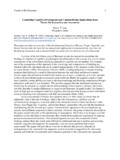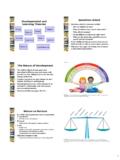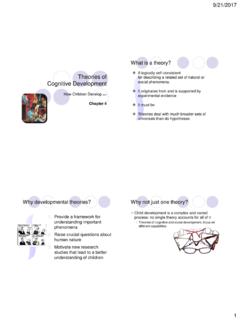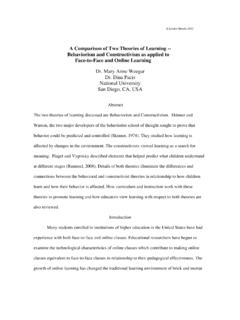Transcription of Theories of Cognitive Development
1 Psychology of ChildhoodTheories ofCognitive DevelopmentCognitive Development Age-related changes in children s knowledge and thinking learning and memory causal knowledge language concepts mental abilities related to academic skillsTheories ofCognitive Development Why do we bother with Theories of Cognitive Development Organize understanding of many individual Cognitive changes Raise crucial questions about human nature Motivate new researchInfluential Theories of Cognitive Development piaget s theory Sociocultural Theories Core-knowledge Theories Information-processing theoriesJean PiagetBeginning about 1920, piaget developed the first co g n i t i ve t h e o r y infant cognition language Development conceptual Development mathematical and scientific reasoning moral Development piaget s Most Revolutionary IdeaChild as their own knowledge from experimenting on the many things on their own without the intervention of older children or intrinsically motivated to learn and do not need rewards from adults to motivate learningPiaget s Principles:What changes?
2 There are distinct stages of Cognitive Development , with the following properties. Qualitative change: Children of different ages (and at different stages) think in different ways. Broad applicability: The type of thinking at each stage pervades topic and content areas. Brief transitions: Transitions to higher stages of thinking are not necessarily continuous. Invariant sequence: The sequences of stages are stable for all people through all time. Stages are not s Principles:What does not change? Three processes work together from birth to account for continuities: Assimilation: People translate incoming information into a form they can understand. Accommodation: People adapt current knowledge structures in response to new experience. Equilibration: People balance assimilation and accommodation to create stable s Principles:How do nature/nurture interact?
3 Nature and nurture interact to produce Cognitive Development . Adaptation: Children respond to the demands of the environment in ways that meet their own goals. Organization: Children integrate particular observations into a body of coherent of piaget s stage (birth to 2 years) Knowledge tied to sensory and motor abilities Fails tests of the object stage (2 to 7 years) Objects and events are represented by mental symbols Fails tests of conser operational stage (7 to 12 years) Children can reason logically about concrete objects and events. Fails to engage in systematic hypothesis operational stage (12 years and up) Children can reason abstractly and s Sensorimotor Stage Substage 1 (birth to 1 month): Reflexive Activity Building knowledge through reflexes (grasping, sucking).
4 No attempt to locate objects that have disappeared Substage 2 (1 to 4 months): Primary Circular Reactions Reflexes are organized into larger, integrated behaviors (grasping a rattle and bringing it to the mouth to suck) Still no attempt to locate objects that have s Sensorimotor Stage Substage 3 (4 to 8 months): Secondary Circular Reactions Repetition of actions on the environment that bring out pleasing or interesting results (banging a rattle). Search for objects that have dropped from view or are partially hidden Substage 4 (8 to 12 months): Coordination of Secondary Reactions Mentally representing objects when objects can no longer be seen, thus achieving object permanence. Search for completely hidden objects but makes A-not-B error. A not B errorPiaget s Sensorimotor Stage Substage 5 (12 to 18 months): Te r t i a r y C i r c u l a r Reactions Actively and avidly exploring the possible uses to which objects can be put Ability to follow visible displacements of an object Substage 6 (18 to 24 months): Symbolic Thought Able to form enduring mental representations, as demonstrated by deferred imitation, the repetition of others behaviors minutes, hours, or days after it has occurred.
5 Ability to follow invisible displacementsInvisible DisplacementPiaget s Preoperational Stage Development of symbolic representations, that is, the use of one object to stand for another. For instance, a stick becomes a horse; an eyepatch and kerchief make a pirate. Characteristic Errors Egocentrism: Looking at the world only from one s own point of view. Centration: focusing on a single, perceptual feature to the exclusion of other featuresEgocentrism in Spatial ReasoningEgocentrism in LanguageCentration in Seriation314 CHAPTER 9 THE GROWTH OF KNOWLEDGE patterns of behavior lend support to the alternative explana-tions for piaget s the studies designed to test the alternative explanations for the patterns of failures and successes on piaget s tasks, young children typically still make errors.
6 But in many cases, their performance also vastly improves in ways that would be difficult to explain if the children truly lacked certain cogni-tive structures, as piaget suggested. Consider, for example, the cases of seriation, thinking about classes, and piaget developed classic seriation tasks, in which a group of objects must be ordered according to a shared property, such as size or height. One of these tasks is to order rods according to their length, which is difficult for children younger than roughly 7 years of age (see Figure ). Their failures at these tasks have often been cited as clear evidence that they lack the ability to use transitive reasoning to under-stand the relationships between several pairs of inequalities (for example, to understand that if Adam is taller than Bill, and Bill is taller than Chris, then Adam also must be taller than Chris).
7 piaget claimed that preoperational children s cog-nitive structures do not allow them to use transitive reasoning when they attempt seriation tasks (Halford et al., 1998).If the younger child truly lacks the ability to use transitive reasoning, then it should be possible to show clear differences between younger and older children on any task that requires this skill. But consider for a moment how piaget s classic seriation tasks actually test a child s transitive reasoning. A child is shown a series of rods of different lengths and asked to order them from shortest to longest. Doing so correctly ABCDEI know that E>D, D>C,C>B, B>A, so D must be greater than is greater, B or D?FIGURE Memory and transitive reasoning. In Bryant and Trabasso s study, researchers trained children by pulling pairs of colored rods out of a holder and showing the children the size differences between the rods.
8 The children memorized the length inequality relationships (E>D, D>C, C>B, B>A) so that they were able to correctly report size inequalities when just looking at the rods inserted in the box. They were then asked about several new inequalities, which they could only determine through transitive reasoning (for example, D>B). In this scenario, in which they were trained on the memory component of the task separately, preopera-tional children could use transitive reasoning to figure out the novel inequalities. This finding suggests that young children had failed at piaget s original seriation task because of problems with memory or attention, not because they were incapable of transitive careful attention to the way each rod s length relates to the others.
9 If you can remember all those relationships, you will quickly know that if rod A is longer than rod B, and rod B is longer than rod C, then rod A is also longer than rod C. You must also remember to look at both ends of the rods and not be swayed by what looks like constant length increases along the tops if the bottoms are also changing relative to each key question about piaget s seriation task is whether children younger than around 7 fail because they are inca-pable of transitive reasoning or because of other elements of the task. For example, younger children may have trou-ble remembering how the length of each rod relates to the lengths of the others. If so, perhaps solving the memory problem would make transitive reasoning easy for them.
10 Peter Bryant and Tom Trabasso conducted an elegant study to figure out whether young children might be fail-ing at seriation tasks because of the tasks memory demands (Bryant & Trabasso, 1971). This study clearly illustrates how carefully designed experiments can tease apart the rea-sons that children fail at Piagetian the setup shown in Figure , Bryant and Tra-basso extensively trained young children to compare pairs of colored rods to determine which was longer. The children learned the length relationships for pairs of rods by associ-ating the lengths with the color of the rods and memoriz-ing the inequalities in the lengths of these different-colored Initial setupYounger child (preoperational)orOlder child(concrete operationaland beyond)FIGURE Seriation.






